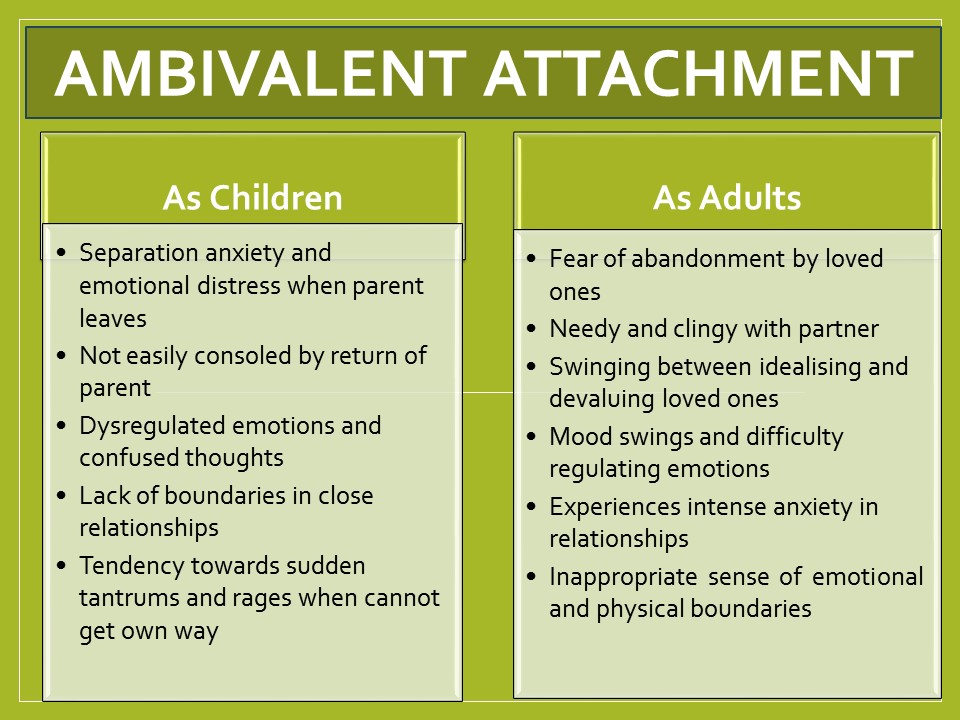Ambivalent Attachment is a form of insecure attachment marked by intense emotional dependence, fear of abandonment, and unpredictable responses to closeness or distance in relationships. Technically known as “anxious-resistant” attachment in infancy, it reflects early experiences of inconsistent caregiving. In accessible terms, people with ambivalent attachment often feel torn about craving connection while fearing it won’t last.
Ambivalent Attachment
| |
|---|---|
| Full Name | Ambivalent (Anxious-Resistant) Attachment |
| Core Characteristics | Intense relational preoccupation, emotional inconsistency, fear of abandonment, clinginess |
| Developmental Origin | Arises from inconsistent caregiving: alternately responsive and unavailable or intrusive |
| Primary Behaviors | Separation distress, difficulty self-soothing, hypervigilance to relational cues |
| Role in Behavior | Leads to emotional dependency, preoccupation with relationships, and difficulty with trust |
| Associated Traits | High anxiety, low avoidance, rumination, emotional intensity |
| Contrasts With | Secure and avoidant attachment styles |
| Associated Disciplines | Developmental psychology, clinical psychology, couples therapy, trauma-informed care |
| Clinical Relevance | Linked to mood disorders, relational instability, codependency, and self-esteem issues |
| Sources: Ainsworth (1978), Bowlby (1969), Mikulincer & Shaver (2007), Cassidy & Berlin (1994) | |
Other Names
Anxious attachment, anxious-preoccupied attachment, resistant attachment
Definition
Ambivalent attachment is when someone craves closeness but fears rejection, leading to mixed feelings in relationships where one wants intimacy but struggles to trust or feel secure with others.
History
Ambivalent attachment was first identified by Mary Ainsworth in her 1978 “Strange Situation” experiments, where infants displayed distress during separation but also ambivalence or anger upon reunion. It expanded Bowlby’s original attachment theory, which emphasized how early caregiver patterns shape future relational expectations.
In adulthood, the term evolved to include “anxious-preoccupied” patterns described in adult attachment frameworks, including Hazan and Shaver’s romantic attachment research in the 1980s.
Mechanism
Ambivalent attachment develops when a child cannot reliably predict caregiver behavior. Over time, this teaches the brain:
- Connection is inconsistent: Attention is sometimes loving, sometimes unavailable or intrusive.
- Emotion must be exaggerated: Strong displays of distress may increase the likelihood of being noticed or comforted.
- Internal models form: “I can’t count on others, but I must cling to them anyway.”
These early patterns persist unless addressed through self-work or therapy.
Psychology
Psychological correlates of ambivalent attachment include:
- Hyperactivation strategies: Escalated emotional pursuit of connection (e.g., excessive calling, texting, or reassurance-seeking).
- Rumination: Persistent worry about the status or feelings of the partner.
- Ambivalence: Push-pull dynamics — simultaneously craving and fearing intimacy.
- Relationship preoccupation: Romantic relationships become central to self-worth regulation.
Neuroscience
Brain and nervous system dynamics include:
- Amygdala hyperactivity: Heightened reactivity to social rejection and emotional threat.
- Anterior cingulate cortex (ACC): Elevated distress response during perceived emotional disconnection.
- Oxytocin dysregulation: Attachment neuropeptide signaling may be unstable, undermining trust and bonding.
- Reduced top-down control: Lower prefrontal regulation of fear and distress responses in conflict.
Ambivalent individuals often feel unable to “think their way out” of relational panic, as emotion dominates logic.
Epidemiology
- Approximately 15–20% of infants in Western populations display anxious-resistant patterns (Ainsworth, 1978).
- Similar prevalence is observed in adult samples using self-report attachment assessments (e.g., ECR, AAI).
- More common in populations with early relational trauma, emotional neglect, or caregivers with unresolved grief or anxiety.
Related Constructs
| Construct | Relationship to Ambivalent Attachment |
|---|---|
| Anxious attachment | Modern adult continuation of the ambivalent pattern in relationships |
| Codependency | Overreliance on relational validation often overlaps with ambivalent traits |
| Hypervigilance | Increased attentiveness to emotional cues due to fear of abandonment |
In the Media
Ambivalent (or anxious-preoccupied) attachment is frequently depicted in film, television, and literature, often driving compelling relationship dynamics. These portrayals showcase characters who crave intimacy but struggle with trust, fear abandonment, and exhibit clingy or jealous behaviors that are each hallmarks of this attachment style.
TV Shows:
- Friends (Ross Geller) – Displays jealousy (“We were on a break!”), over-the-top gestures, and fear of abandonment
- The White Lotus (Tanya McQuoid) – Exhibits desperate clinginess and dramatic reactions to perceived rejection
- Sex and the City (Carrie Bradshaw) – Seeks validation while sabotaging stability in her long-term relationship by cheating on Aidan
Movies:
- 500 Days of Summer (Tom Hansen) – Hyper-fixates on Summer and spirals when rejected
- Eternal Sunshine of the Spotless Mind The character Clementine impulsively seeks attention while fearing engulfment
Books:
- Normal People (Connell) – Anxiety about losing Marianne ties self-worth to her approval
Current Research Landscape
Research on ambivalent attachment appears in developmental psychology, social neuroscience, couples therapy, and trauma studies. Key topics include early caregiving, relational dependency, emotion regulation, and neural correlates of rejection sensitivity.
FAQs
Is ambivalent the same as anxious attachment?
Yes. “Ambivalent” is typically used for childhood attachment; “anxious” or “preoccupied” is used for adults but reflects similar behaviors.
Can ambivalent attachment change?
Yes. Through therapy, secure relationships, and emotional regulation practices, individuals can move toward secure attachment.
Why do people with this style seem unpredictable?
Because their early experiences taught them that love is inconsistent. This creates push-pull behaviors — craving closeness but fearing its loss.
What is the best therapy for ambivalent attachment?
Attachment-based, emotionally focused therapy (EFT), and somatic trauma work are often recommended.





